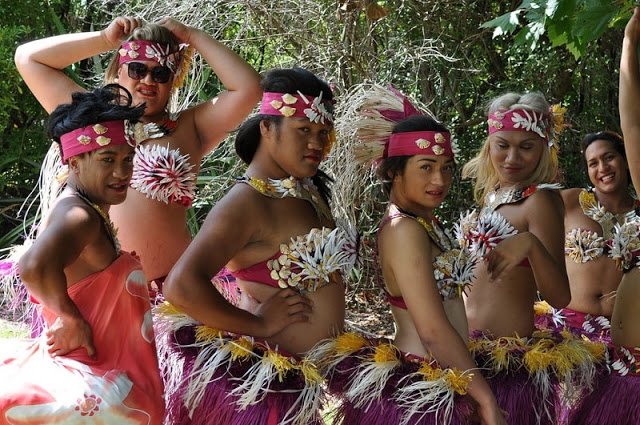by Staff writer
Living alone in a tiny house just outside the Savai’i village of Alaolemativa, Hazy Pau Talauati is a Samoan man who dresses and lives as a woman.
She is a fa’afafine.
Like most fa’afafine in Samoa – and there are a few in most villages – Hazy is an accepted member of the community, valued for the work she does.
Samoa’s social acceptance of fa’afafine has evolved from the tradition of raising some boys as girls.
These boys, were not necessarily homosexual, or noticeably effeminate, and they may never have felt like dressing as women.
They became transvestites because they were born into families that had plenty of boys and not enough girls.
Traditionally, if a family had more boys than girls or not enough girls to help with women’s duties about the house, male children would be chosen to be raised as fa’afafine.
It has been estimated that 1-5% of Samoans identify as fa’afafine.
In families of all male children (or where the only daughter was too young to assist with the ‘women’s’ work), parents would often choose one or more of their sons to help the mother.
Because these boys would perform tasks that were strictly the work of women they were raised as if they were female.
Although their true gender was widely known, they would usually be dressed as girls.
As they grow older, their duties would not change. They would continue performing ‘women’s’ work, even until marriage (which in most cases would be to a woman).
Modern fa’afafine differ in two fundamental ways from their traditional counterparts.
First, they are more likely to have chosen to live as women, and, secondly, they are more likely to be homosexual. These days, young Samoan boys who appear effeminate, or enjoy dressing as girls, may be recognised as fa’afafine by their parents.
If they are, they will usually be neither encouraged nor discouraged to dress and behave as women. They will simply be allowed to follow the path they choose.
If it becomes apparent that a boy wants to become a fa’afafine, he will be taught the duties and crafts of women. Coupling those skills with the strengths of Samoan men can make a fa’afafine an extremely valuable member of society.
‘When I was young, my parents looked at me and the way I am…and they think, Oh Hazy, she must not be a boy, but something else. And then, they never accuse me…they really accept me. They understand what I am, in my body,’ Hazy Pau Talauati says.
‘I think there’s a little bit difference between fa’afafine here in Samoa and overseas, because here the fa’afafine can help the mother [by] doing the same job… and they can do the men’s job as well. I think that’s why the fa’afafine here are so popular, because they are hard working people.’
Along with their hard work, modern fa’afafine are known for their good works.
Samoan fa’afafine, for example, run an annual transvestite beauty pageant, the proceeds of which are donated to charities which support the elderly and the disabled.
For these sorts of contributions to the community, some fa’afafine have been awarded customary titles.
Hazy narrates: ‘When they see me…everybody, from the west to the east, even the children…they yell out, “Hazy! Hazy!” They call my name. So I ask my friends, “If I go on the ballot for an MP, I’m sure that I’m going to win!”
She laughs.
***
Credit: ABC.net




My Samoan wife was raised fa’afafine. She was the fifth child (2 older brothers and 2 older sisters) that were sevral years older than her. It was decided at birth for her to be fa’afafine and she was given an androgynous name and listed as female on her birth certifcate. Her parents were older and it was intended for her to care for them in old age. At 21 she moved to the US to help her older brother, who was in the Navy, and his wife with their children. This was in the 1980s and American culture has no equivilent to the fa’afafine, so her brother told her to just always present herself as a woman so she wouldn’t have to explain her circumstance, and to avoid discrimination and harassment. This wasn’t a problem since her passport listed her as female and she had started a male depressing and female hormones when she turned 18. It also helped that she is only 5’4″. Over the years she helped with several of her siblings’ children, known to them only as a woman. She became a licensed hairstylist working parttime. Several years later she returned to American Samoa to care for her parents. The older family and friends knew she was fa’afafine, but everone else only knew her as a woman. After her parents passing when she was appraching 50, she returned to the US close to her oldest brother. That’s when we met at the Christmas party of mutual friends. I had been widowed for 4 years and was just considering dating again. I only knew her as a woman when we started dating, but when I exppresed my to desire for a more serious relationship including intimacy (as mature adults we had mutually decide not to engage in casual sex), she told me all about herself. It was completely unexpected and I was taken back a bit. After a few days I asked her to meet to discuss my decision. I told her it was hard for me to tell her what I had decided, but that I could express my decision by showing her. I showed her with our first kiss. Two months later she went to American Samoan for a month, and when she returned, I proposed. She accepted and we were married 2 months later. She is now a loving stepmother to my children and doting grandmother to our grandchildren, and a wonerful daughter-in-law to my parents, and sister-in-law to my siblings. Since all of her neices and nephews and younger extended family only know her has a woman, we chose not to tell my family about her male genatalia. She calls her marriage, motherhood, and being a grandmother the “fairytale” chapter to her wonderful life.